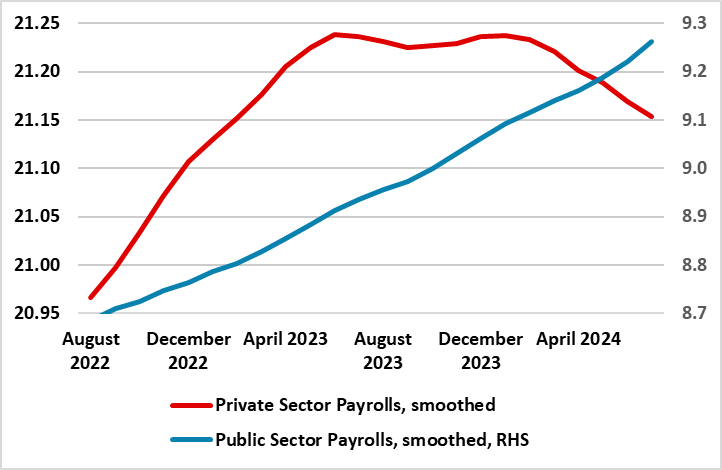UK Jobs Data: A Tale of Two Markets
Amid distortions in much of the labor market data, the BoE is focusing on private sector numbers, especially given the added distortion of recent and looming high public sector ay awards. In that regard it will get some solace from today’s average earnings data which show private regular pay at the lowest in over two years. But at 4.9% it was still a little above what may have been excessively soft BoE expectations. But rather than focusing on pay, perhaps the BoE should start to ponder over the employment numbers, at least those authoritative figures provided by His Majesty’s Revenue and Customs (HMRC). As we have highlighted before they show a continued weakness in employment that questions the validity and/or durability of recent upbeat GDP data as well as the latest surprise drop in the unemployment rate. But the fact that this weakness actually reflects even sharper fall in private sector jobs (Figure 1), also questions the validity and/or durability of ever more upbeat PMI numbers (Figure 2) whose coverage excludes the public sector.
Figure 1: Sharp Fall in Private Payrolls Contrast with Stronger Government Jobs

Source; ONS, HMRC, millions
Private Pay Growth Down...
Given the impact of very sizeable pay wards, both actual and anticipated, there is clear merit and method is concentrating on private sector pay, not least as it should better chime with cyclical developments. Thus the fall to 4.9% in June, the lowest since spring 2022 will be reassuring to the BoE, even the hawks. Admittedly, the data is also affected by the sampling problems that bedevil all ONS-compiled labor market numbers, but HMRC pay data have also show a clear slowing late. This is important as HMRC data is very authoritative in that it covers all those who are employed and paying tax as opposed to the extrapolation needed with survey data. Indeed, mean pay on this basis slowed to a four-year low of 3.3% in June, albeit where median pay picked up on base effects but are usually more volatile anyway.
...While Private Jobs Slump
Notably, just as HMRC-compiled pay data are still statistically sound and authoritative, so are the payroll data that are compiled alongside. These cover the 30.4 mln of those officially employed and as we have been noting have been showing a slowing of late, at least in terms of private sector payrolls. What is perhaps less known is that while overall payroll jobs have risen, (up around 250K in the last year) this is solely due to public sector worker increases - a circa-325K rise in the last year (Figure 1). Around half of this rise is health and social care and a quarter on education. But amid ever-clearer signs of intensifying fiscal consolidation, question must be asked about the durability of such public sector jobs gains even given the clear commitment to the NHS.
Figure 2: Sharp Fall in Private Payrolls Contrast with Upbeat PMIs

Source; ONS, HMRC
Regardless, the weakness in private sector payrolls also conflicts with the updated GDP and PMI survey data seen of late, the latter seemingly offering insights into the economy excluding government, finance and retail. It is rare to see private sector jobs fall while GDP and/or the PMIs rise, the latter very much highlighted by Figure 2. This adding to our qualms about what is generating this PMI upturn just as such data in the Eurozone have taken a turn for the worse. All of which adds to our doubts about the apparent UK economy recovery, both in term of validity and durability!